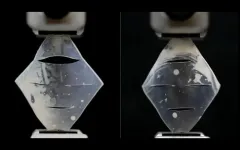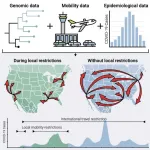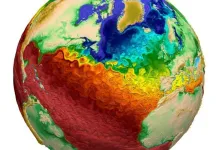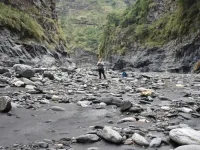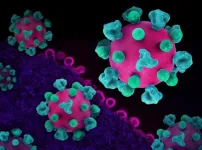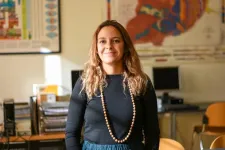(Press-News.org) Washington, D.C. – The Office of Fusion Energy Sciences (FES), at the U.S. Department of Energy’s Office of Science, announced the release of its vision, Building Bridges: A Vision for the Office of Fusion Energy Sciences, during the Fusion Energy Sciences Advisory Committee hearing on December 13, 2023. This FES vision enables DOE to establish the steps needed to help advance fusion energy, including addressing key science and technology gaps in the supply chain and industry, bringing the United States one step closer to achieving net-zero emissions by 2050.
Fusion, the process that powers the Sun, is one of the most environmentally friendly sources of energy. The fusion process produces no harmful carbon emissions or greenhouse gases, offering the potential to provide abundant, reliable, and non-carbon-emitting energy. The new Building Bridges vision seeks to align FES program elements in support of the Bold Decadal Vision for Commercial Fusion Energy—which requires aggressively addressing significant scientific and technological gaps to enable one or more viable fusion-pilot-plant designs as part of the effort to achieve the Administration’s ambitious climate and energy goals.
“DOE’s Office of Fusion Energy Sciences is poised to shape and execute a vision that will bring all stakeholders, both domestic and abroad, together as we work to engage and develop a fusion energy research, development, and demonstration ecosystem for the 21st century,” said Asmeret Asefaw Berhe, Director of DOE’s Office of Science. “Our goal is to help establish a long-term sustainable and flourishing scientific research enterprise for fusion energy and plasma science that will help accelerate these technologies to commercialization.”
Fusion occurs when two light nuclei combine to form a new heavier nucleus. Creating conditions for fusion on Earth involves generating and sustaining a plasma, which are gases that are so hot that electrons are freed from atomic nuclei. Researchers use electric and magnetic fields to control the resulting collection of ions and electrons because they have electrical charges. At sufficiently high temperatures, ions can overcome repulsive electrostatic forces and fuse together. This process—fusion—releases energy. Generating controlled fusion on Earth, however, is a challenge due to various scientific and technological gaps. For example, it is difficult to obtain a high enough plasma temperature for a long enough time to produce meaningful amounts of fusion power.
The Building Bridges vision aims to build bridges that connect government, academia, and the private sector focused on a staged approach towards fusion energy development. Included in the vison are the following key elements:
Workforce Development and Sustainment: Ensuring the establishment of sustainable and resilient pathways for diverse and exceptional talent.
Bridging Gaps: Creating innovation engines with DOE national laboratories, universities, and industry to resolve research and development gaps and support domestic supply chains for fusion energy.
Transformational Science: Nurturing plasma science and technology discovery translating to innovation impact.
“Our focus is to bring new talent to our fusion ecosystem and support our existing workforce with innovative programs including access to world-class fusion facilities. In addition, we want to build bridges with industry and develop new partnerships that leverage talent and infrastructure to accelerate the science and technology needed to realize fusion,” explained Jean Paul Allain, Associate Director, DOE’s Office of Fusion Energy Sciences. “As a part of these efforts, we will broaden and diversify program elements in FES, including emerging plasma concepts to reflect discovery plasma science and technology that could ultimately have a broad impact in society.”
Under the Building Bridges vision, FES will align resources to gain traction toward resolving fusion materials and technology gaps that connect the following three science drivers: (1) sustain a burning plasma, (2) engineer for extreme conditions, and (3) harness fusion energy.
Additionally, FES will develop a Fusion Science and Technology Roadmap that will guide priorities and investments in the coming decade. The development of this roadmap will include input from the Fusion Energy Sciences Advisory Committee along with community workshops hosted by DOE’s Office of Science and multiple relevant reports. FES will also work closely with public and private sector performers to prioritize investments in facilities and strategic initiatives, and the office will leverage international partnerships supported by the recently announced U.S. fusion international strategy, which was announced at COP28 by Special Presidential Envoy for Climate John Kerry.
“The Office of Science and this program have an incredibly important role in helping to advance fusion energy and make it competitive in future energy markets, but we cannot do it alone,” said Associate Director Allain. “We have established a valuable vision that will guide our engagement with offices across DOE, our national laboratories, industry, universities, non-governmental organizations, communities, the interagency and international partners, as we work toward achieving a clean energy future.”
Visit the Office of Scientific and Technical Information website to view the presentation from the Fusion Energy Sciences Advisory Committee hearing to learn more about FES’ vision.
END
DOE’s Office of Science releases vision outlining the path to advancing fusion energy science and technology
The new Building Bridges vision seeks to align FES program elements in support of the Bold Decadal Vision for Commercial Fusion Energy
2023-12-14
ELSE PRESS RELEASES FROM THIS DATE:
Rubber that doesn’t grow cracks when stretched many times
2023-12-14
Researchers from the Harvard John A. Paulson School of Engineering and Applied Sciences (SEAS) have increased the fatigue threshold of particle-reinforced rubber, developing a new, multiscale approach that allows the material to bear high loads and resist crack growth over repeated use. This approach could not only increase the longevity of rubber products such as tires but also reduce the amount of pollution from rubber particles shed during use.
The research is published in Nature.
Naturally occurring rubber latex is soft and stretchy. For a range of applications, including tires, hoses, and dampeners, rubbers are reinforced by ...
Social distancing was more effective at preventing local COVID-19 transmission than international border closures
2023-12-14
LA JOLLA, CA—Elucidating human contact networks could help predict and prevent the transmission of SARS-CoV-2 and future pandemic threats. A new study from Scripps Research scientists and collaborators points to which public health protocols worked to mitigate the spread of COVID-19—and which ones didn’t.
In the study, published online in Cell on December 14, 2023, the Scripps Research-led team of scientists investigated the efficacy of different mandates—including stay-at-home measures, social distancing and travel restrictions—at preventing local and regional transmission during different phases of the COVID-19 pandemic. They found ...
Custom software speeds up, stabilizes high-profile ocean model
2023-12-14
On the beach, ocean waves provide soothing white noise. But in scientific laboratories, they play a key role in weather forecasting and climate research. Along with the atmosphere, the ocean is typically one of the largest and most computationally demanding components of Earth system models like the Department of Energy’s Energy Exascale Earth System Model, or E3SM.
Most modern ocean models focus on two categories of waves: a barotropic system, which has a fast wave propagation speed, and a baroclinic system, which ...
Can you change a chicken into a frog, a fish or a chameleon?
2023-12-14
Gastrulation is one of the most important phases in early embryonic development. Before gastrulation, vertebrate embryos are simple two-dimensional sheets of cells. By the end of gastrulation, an embryo will have begun to differentiate distinct cell types, set up the basic axes of the body and internalize some of the precursors for organs in a three-dimensional structure. Amniotes, like chickens and humans, will have developed a primitive streak, the precursor to the brain and skin, while fish and amphibians will have developed a spherical-shaped ...
How the immune system fights to keep herpes at bay
2023-12-14
Herpes simplex virus (HSV) is extremely common, affecting nearly two-thirds of the world’s population, according to the World Health Organization.
Once inside the body, HSV establishes a latent infection that periodically awakens, causing painful blisters on the skin, typically around the nose and mouth. While a mere nuisance for most people, HSV can also lead to dangerous eye infections and brain inflammation in some people and cause life-threatening infections in newborns.
Researchers have long known ...
Drones capture new clues about how water shapes mountain ranges over time
2023-12-14
UNIVERSITY PARK, Pa. — Drones flying along miles of rivers in the steep, mountainous terrain of central Taiwan and mapping the rock properties have revealed new clues about how water helps shape mountains over geological time, according to a team led by Penn State scientists.
The researchers found a link between the size of boulders in the rivers and the steepness of the rivers. The link shows how rock properties can influence the relationship between tectonic processes happening deep underground and how mountainous landscapes ...
NIH research identifies opportunities to improve future HIV vaccine candidates
2023-12-14
WHAT:
An effective HIV vaccine may need to prompt strong responses from immune cells called CD8+ T cells to protect people from acquiring HIV, according to a new study from researchers at the National Institute of Allergy and Infectious Diseases (NIAID), part of the National Institutes of Health, and colleagues. The study findings, appearing in Science, draw comparisons between the immune system activity of past HIV vaccine study participants and people with HIV who naturally keep the virus from replicating even in the absence of antiretroviral ...
Can an app improve your romantic relationship?
2023-12-14
Half of all marriages in the United States are likely to fail by the time the spouses reach their 50s. Understandably, many couples are looking for ways to avoid becoming part of that statistic, well aware of a divorce’s possible wide-reaching detrimental effects on families, children, personal finances, individual well-being—and direct and indirect costs to society.
Ronald Rogge, an associate professor of psychology at the University of Rochester, has been researching the complex dynamics ...
Climate-smart ocean planning in Antarctica awarded with 1.5M€ ERC starting grant
2023-12-14
Catarina Frazão Santos, researcher at the Faculty of Sciences of the University of Lisbon (Portugal) (Ciências ULisboa), has been awarded by the European Research Council (ERC) with a Starting Grant of approximately 1.5 million euros to study the benefits and challenges of developing sustainable, equitable and climate-smart marine spatial planning processes in Antarctica and beyond.
“We need to raise awareness and foster a ‘paradigm shift’ on how to plan for sustainability and equity in a changing ocean,” says Catarina ...
Researchers, Coast Salish people analyze 160-year-old indigenous dog pelt in the Smithsonian’s collection
2023-12-14
Researchers from the Smithsonian’s National Museum of Natural History led a new analysis that sheds light on the ancestry and genetics of woolly dogs, a now extinct breed of dog that was a fixture of Indigenous Coast Salish communities in the Pacific Northwest for millennia. Anthropologist Logan Kistler and evolutionary molecular biologist Audrey Lin analyzed genetic clues preserved in the pelt of “Mutton,” the only known woolly dog fleece in the world, to pinpoint the genes responsible for their ...
LAST 30 PRESS RELEASES:
Tracing the quick synthesis of an industrially important catalyst
New software sheds light on cancer’s hidden genetic networks
UT Health San Antonio awarded $3 million in CPRIT grants to bolster cancer research and prevention efforts in South Texas
Third symposium spotlights global challenge of new contaminants in China’s fight against pollution
From straw to soil harmony: International team reveals how biochar supercharges carbon-smart farming
Myeloma: How AI is redrawing the map of cancer care
Manhattan E. Charurat, Ph.D., MHS invested as the Homer and Martha Gudelsky Distinguished Professor in Medicine at the University of Maryland School of Medicine
Insilico Medicine’s Pharma.AI Q4 Winter Launch Recap: Revolutionizing drug discovery with cutting-edge AI innovations, accelerating the path to pharmaceutical superintelligence
Nanoplastics have diet-dependent impacts on digestive system health
Brain neuron death occurs throughout life and increases with age, a natural human protein drug may halt neuron death in Alzheimer’s disease
SPIE and CLP announce the recipients of the 2025 Advanced Photonics Young Innovator Award
Lessons from the Caldor Fire’s Christmas Valley ‘Miracle’
Ant societies rose by trading individual protection for collective power
Research reveals how ancient viral DNA shapes early embryonic development
A molecular gatekeeper that controls protein synthesis
New ‘cloaking device’ concept to shield sensitive tech from magnetic fields
Researchers show impact of mountain building and climate change on alpine biodiversity
Study models the transition from Neanderthals to modern humans in Europe
University of Phoenix College of Doctoral Studies releases white paper on AI-driven skilling to reduce burnout and restore worker autonomy
AIs fail at the game of visual “telephone”
The levers for a sustainable food system
Potential changes in US homelessness by ending federal support for housing first programs
Vulnerability of large language models to prompt injection when providing medical advice
Researchers develop new system for high-energy-density, long-life, multi-electron transfer bromine-based flow batteries
Ending federal support for housing first programs could increase U.S. homelessness by 5% in one year, new JAMA study finds
New research uncovers molecular ‘safety switch’ shielding cancers from immune attack
Bacteria resisting viral infection can still sink carbon to ocean floor
Younger biological age may increase depression risk in older women during COVID-19
Bharat Innovates 2026 National Basecamp Showcases India’s Most Promising Deep-Tech Ventures
Here’s what determines whether your income level rises or falls
[Press-News.org] DOE’s Office of Science releases vision outlining the path to advancing fusion energy science and technologyThe new Building Bridges vision seeks to align FES program elements in support of the Bold Decadal Vision for Commercial Fusion Energy
